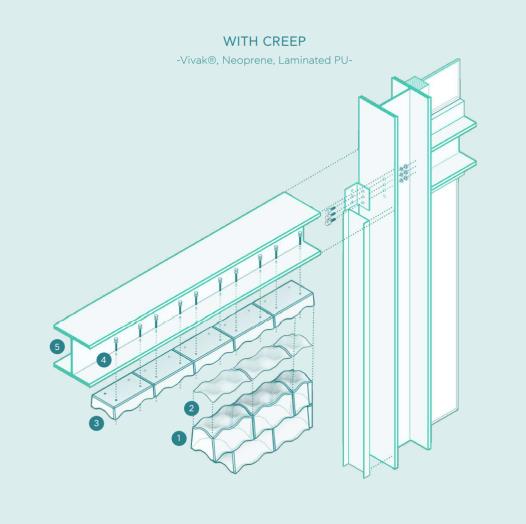IN BETWEEN: An Interlayer Material Study for Interlocking Cast Glass Blocks
DOI:
https://doi.org/10.47982/cgc.8.416Downloads

Abstract
Interlocking cast glass assemblies are a promising solution for architectural cast-glass applications aiming for high transparency and a reversible structure that allows the reuse of the glass components (Oikonomopoulou et al.,2018; Oikonomopoulou,2019b). In such a system, an interlayer material between the glass elements is essential, to assist the homogenous stress distribution and account for the surface microasperities of the glass elements. Towards circularity, this material should be dry (and not an adhesive), allowing for the eventual disassembly of the system. Previous experimental work by (Aurik at al.,2018; Oikonomopoulou at al.,2019b) has focused on the use of PU and PVC interlayers as suitable candidates; the focus in those studies has been solely placed on the mechanical performance of the interlayer material. This research provides a review of potential material candidates suitable for interlayers of an interlocking cast glass assembly based on a set of revised design and performance criteria that are divided into primary and secondary. Furthermore, the impact their unique material properties have on the potential application of the interlocking system is examined. The whole process, from fabrication to construction of the entire assembly, based on an assumed building scenario, is presented in a chain reaction manner, whose starting point is the interlayer itself. After defining the design criteria the interlayer should adhere to, the proposed candidates are: PETG sheets (Vivak®), Neoprene, Aluminum, Laminated Polyurethane (PU) and a Soft-core aluminum interlayer. The unique properties and fabrication challenges of all five proposed interlayers are considered, as well as their properties in relation to assembly, which leads to the development of two distinct assembly sequences. The main distinction concerns the interlayers that risk creeping and those that do not. The research concludes with a comparison between the interlocking assembly and the other glass block assemblies currently applied.
Published
Issue
Section
Design Philosophy & Structural Safety
License
Copyright (c) 2022 Maria Dimas, Faidra Oikonomopoulou, Marcel Bilow

This work is licensed under a Creative Commons Attribution 4.0 International License.



